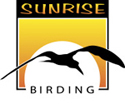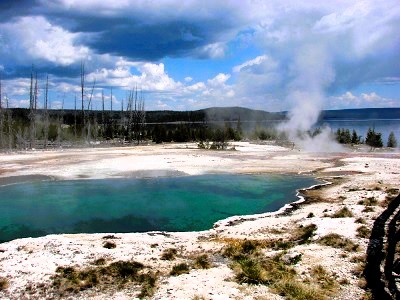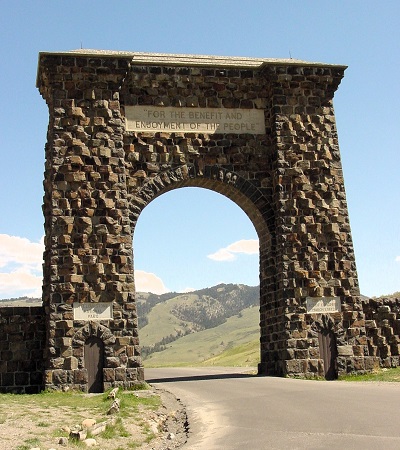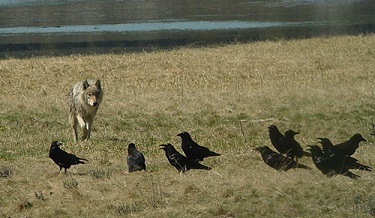Home | Tours | Trip Reports | News | Team | Calendar | Links | Contact | Store | Mailing List

 YELLOWSTONE
YELLOWSTONEwith Denver Holt
March 15 - 21, 2026
Trip Cost> Registration Form(pdf)>
Tour Registration, Terms, Cancellation Policies>
In early spring, Yellowstone National Park begins to stir from its long winter slumber. The landscape is a mix of melting snow, budding trees, and cool mornings that give way to warm afternoons. The rivers, swollen from the runoff, rush through valleys and canyons with a determined force, while patches of snow linger in the higher elevations. The park’s iconic wildlife, emerging from the quiet of winter, is a sight to behold—bison graze where they can find grass beginning to reclaim the meadows, and elk wander cautiously through the thawing terrain. The iconic geothermal features—hot springs, geysers, and fumaroles—puff steam into the cool air. It is a time of transition, where the lingering quiet of winter begins to mingle with the vibrant life of spring, creating a peaceful yet exhilarating atmosphere.
Join us on an exploration of our country’s first national park with its abundant mammals including Bison, Elk, Gray Wolf, Moose, Bighorn Sheep, Pronghorn, Coyote, Mountain Goat, River Otter, Beaver, Marten, and Red Fox.
A variety of birds are possible including everything from massive Trumpeter Swans to Barrow’s Goldeneye, raptors including Bald and Golden Eagles, Rough-legged Hawk, and Prairie Falcon, and a host of mountain and western specialties including Townsend’s Solitaire, American Three-toed Woodpecker, Mountain Chickadee, Black and Gray-crowned Rosy-finches, Clark’s Nutcracker, Steller’s Jay, American Dipper, Mountain Bluebird, Pine Grosbeak, Bohemian Waxwing, Ruffed Grouse, Red Crossbill, and more.
Our tour starts in Bozeman, Montana, and stages in Gardiner, Montana founded in 1880 and still serving as a main entrance to Yellowstone National Park. From Gardiner we can access the park through the iconic Roosevelt Arch to explore the north portion of the park from Gardiner to Cooke City and wildlife viewing sites such as the Lamar Valley, various spots on the Yellowstone River, Mammoth Hot Springs, Paradise Valley, and others.
This tour will be led by long time friend Denver Holt, founder of the Owl Research Institute in Charlo, Montana. Denver is a dedicated field researcher and an expert on the ecology and wildlife of Yellowstone. Gina Nichol and Steve Bird will also accompany this tour.
Join us to experience the rich biodiversity of America's first National Park!
 ITINERARY
ITINERARY
March 15, Day 1: Arrival in Bozeman, Montana
Plan on arrival in Bozeman, Montana today (Bozeman International Airport, code BZN). When you arrive at the airport, take the complimentary airport shuttle to our hotel. Check in time is 3 PM. We will meet in the hotel lobby this evening for a welcome and tour orientation followed by dinner. NIGHT: Bozeman, MT
March 16 – 19, Days 2-5: Yellowstone National Park
Today we head south from Bozeman to Gardiner on the northern border of Yellowstone National Park. Passing through the Paradise Valley, you’ll start to get a feel for the vast open space and diverse, often rugged terrain of “Big Sky Country”. We have 4 full days to explore the Greater Yellowstone Ecosystem and scenic grandeur and diversity of natural hydrothermal features, wildlife, vegetation, lakes, and geologic wonders.
Once in the park proper, you’ll begin to experience some of its thousands of hydrothermal features that evidence volcanic activity over the ages. Mammoth Hot Springs, fed by hot water that comes from the Norris Geyser Basin, is a large complex of natural terraces created over thousands of years as water from the spring cooled and deposited calcium carbonate on the landscape. You’ll start to see the variety of habitats that cover Yellowstone’s high plateau country with sprawling sagebrush grasslands, meadows, glacier-carved valleys, boreal forests, and alpine tundra as well as scenic lakes and rivers.
For the next four days we will discover the natural treasures of the northern reaches of Yellowstone, birding and searching for wildlife. We’ll explore the region from the only road through Yellowstone that is open at this time of year, the road between Gardiner and Cooke City, Montana just outside the northeast  entrance of the park. Each day’s exploration will depend on where we expect to encounter the wildlife and we will certainly spend time in the famed Lamar Valley where animals will likely be concentrated.
entrance of the park. Each day’s exploration will depend on where we expect to encounter the wildlife and we will certainly spend time in the famed Lamar Valley where animals will likely be concentrated.
Bison, Elk and Wolves roam the landscape and Grizzlies should be emerging from winter hibernation in March. Red Fox and Coyote are quite common and, Moose, Mule Deer, Bighorn Sheep, and Pronghorn are all possible. If we are lucky, we’ll catch a glimpse of the elusive Mountain Lions that are in the park.
We’ll also be searching out several late winter/early spring birds. Any open water will attract waterfowl and depending on the conditions we can find Trumpeter and Tundra Swan, Barrow’s and Common Goldeneye, Bufflehead, and Common Merganser. We’ll check the rivers and streams for American Dipper that are active throughout the year. We’ll watch for Ravens and Magpies that can often lead us to wolf kills. Black-billed Magpie, Clark’s Nutcracker, Canada and Steller’s Jays should be encountered and we will always be watching for raptors including Rough-legged and Red-tailed Hawks and Bald and Golden Eagles and even Prairie Falcon.
Forest and woodlands can yield thrushes and bluebirds and we’ll search for Townsend’s Solitaire and maybe some Mountain Bluebirds returning from their wintering grounds and adding brilliant blue to the landscape. We’ll check spots for American Three-toed Woodpecker, Pine Grosbeak, Ruffed Grouse, and Red Crossbill, and hope that Bohemian Waxwings reveal themselves.
And we’ll hope to find some owls, Denver’s specialty but naturally elusive, including Great Horned, Great Gray, and Northern Pygmy-Owl. We’ll also visit some friend’s feeders that can attract Black and Gray-crowned Rosy-Finches, Pine Grosbeak and sometimes Pine Marten.
Denver will share his expertise about how animals adapt to the extreme and ever-changing conditions of the Greater Yellowstone ecosystem. He’ll discuss the life histories of the birds and mammals and how some of them, like the Gray Wolf, have reshaped the ecology of Yellowstone. Our time in and around the park is sure to be exciting, enlightening, and unforgettable. NIGHTS: Gardiner, MT
March 20, Day 6: Yellowstone to Bozeman
Today we leave Gardiner heading north and birding our way toward Bozeman through the famed Paradise Valley following the Yellowstone River. This scenic valley features the Absaroka Range to the east and the Gallatin Range to the west. We’ll make stops for birding and wildlife viewing eventually reaching Bozeman for our last night of the tour. Later on, we’ll enjoy a final dinner in Bozeman and a review of our sightings for the trip. NIGHT: Bozeman, MT
March 21, Day 7: Departures from Bozeman
Departures from Bozeman can be any time today using the hotel shuttle to the airport.
Contact gina@sunrisebirding.com to reserve your space!
March 15 - 21, 2026 REGISTRATION FORM (pdf)> Contact gina@sunrisebirding.com to reserve your space!
Once
the tour is confirmed
to go
ahead, we will send
you information
about booking your
flights.
Please
do not book flights until
you receive this information
from us and are notified that
the trip has sufficient numbers
to run. **Please note: Tour prices are based on quoted costs from ground operators (in their local currency), estimated fuel costs, and the rate of exchange the time of itinerary publication. The erratic nature to global financial markets makes it difficult to predict changes in costs and foreign currency exchange rates over the long term. Since tours are priced well in advance of the actual operation of the tour, tour costs, fuel costs and exchange rates can change, sometimes drastically. Depending on the extent of such changes, it may be necessary to implement a surcharge on this tour. If a surcharge is necessary, every effort will be made to minimize the amount.
Cancellations
and
Refunds:
TRIP INSURANCE: PLEASE NOTE
Questions? Contact Gina Nichol at gina@sunrisebirding.com |